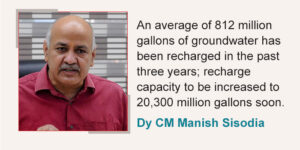
 he Kejriwal Government is working vigorously on a plan to reduce the water shortage in the national capital and ensure 24×7 water supply. Delhi Government’s ‘Palla Floodplain Project’ to recharge ground water by harvesting the water coming through flood in Yamuna river during monsoon has proved to be a tremendous milestone in this direction. Due to the Palla Floodplain Project in Delhi, the ground water level is continuously improving.
he Kejriwal Government is working vigorously on a plan to reduce the water shortage in the national capital and ensure 24×7 water supply. Delhi Government’s ‘Palla Floodplain Project’ to recharge ground water by harvesting the water coming through flood in Yamuna river during monsoon has proved to be a tremendous milestone in this direction. Due to the Palla Floodplain Project in Delhi, the ground water level is continuously improving. Deputy Chief Minister Manish Sisodia said that the Yamuna passing through the capital gets flooded almost every year during the monsoon, in which crores of litres of water used to flow through the Yamuna. In such a situation, the Kejriwal Government started the eco-friendly Palla project three years ago in the floodplain near the Yamuna river to collect this excess flood water passing through the river during the monsoon season.
Deputy Chief Minister Manish Sisodia said that the Yamuna passing through the capital gets flooded almost every year during the monsoon, in which crores of litres of water used to flow through the Yamuna. In such a situation, the Kejriwal Government started the eco-friendly Palla project three years ago in the floodplain near the Yamuna river to collect this excess flood water passing through the river during the monsoon season.This website uses cookies to improve your experience. We'll assume you're ok with this, but you can opt-out if you wish. Accept Read More
